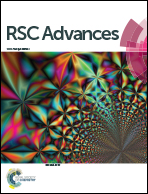Orange red emitting naphthalene diimide derivative containing dendritic wedges: aggregation induced emission (AIE) and detection of picric acid (PA)†
Abstract
Herein we report the synthesis, characterization and photophysical properties of novel naphthalene diimide (NDI) derivatives containing naphthalene units which are covalently attached to either end of the NDI. The self-assembly of such ‘Donor–Acceptor–Donor’ dendritic wedges shows aggregation induced emission (AIE), which in turn results in bright orange red emission from the NDI system, in aqueous medium and solid state. The structure of self-assembly has been analyzed using X-ray diffraction, variable temperature IR and NMR spectroscopy, scanning and transmission electron microscopy, steady state and time resolved emission spectroscopy. The results suggest that the emission quantum yields in the solid state vary inversely proportional to the number of donor units (naphthalene) attached to the NDI core. The NDI derivatives have been utilized to prepare organic nanoparticles (ONPs) in suitable solvent mixtures. Further, the ONPs as well as the solid thin film formed from the NDI derivative were utilized for the detection of picric aid through fluorescence quenching experiments, with a detection limit of 0.90 ppm.


 Please wait while we load your content...
Please wait while we load your content...